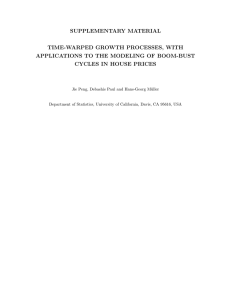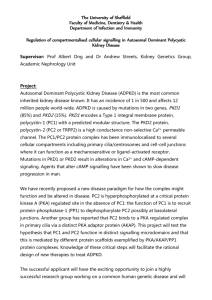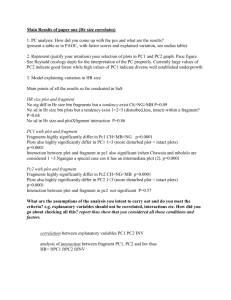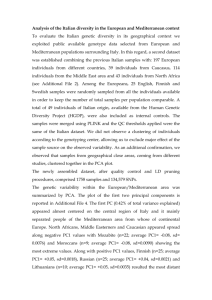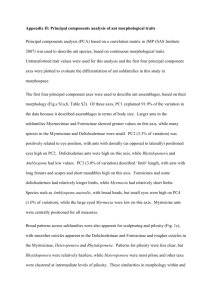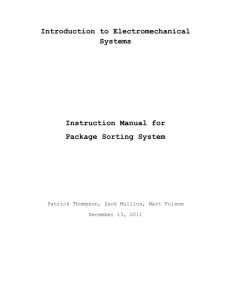The methods reported in our recently published paper (1) vary
advertisement
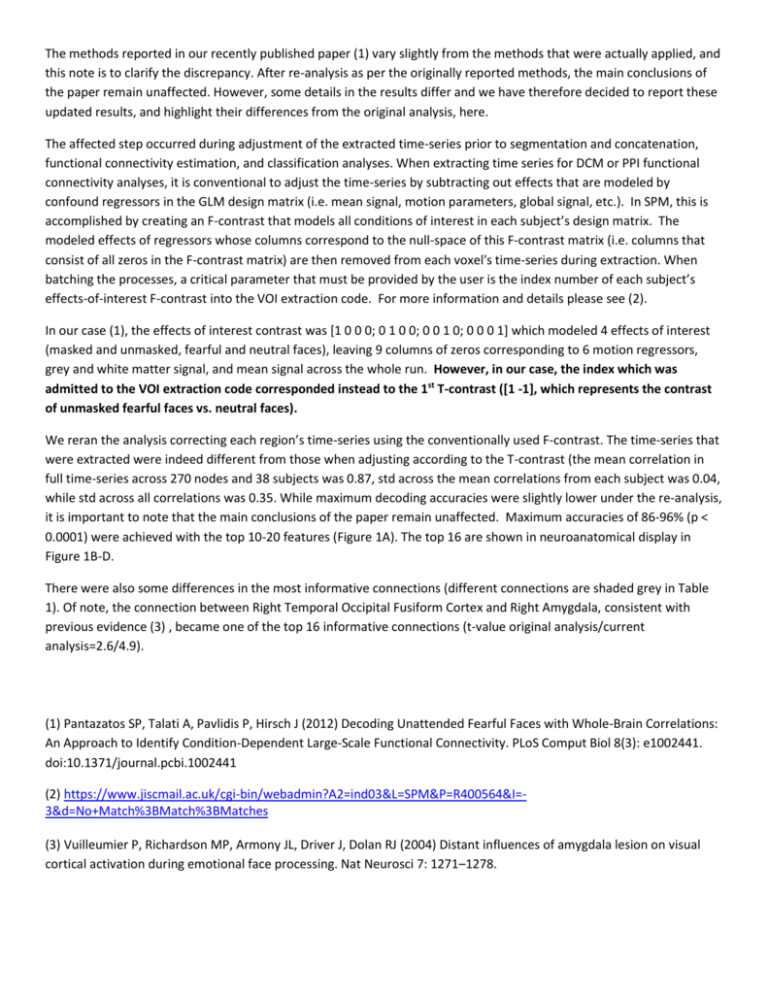
The methods reported in our recently published paper (1) vary slightly from the methods that were actually applied, and this note is to clarify the discrepancy. After re-analysis as per the originally reported methods, the main conclusions of the paper remain unaffected. However, some details in the results differ and we have therefore decided to report these updated results, and highlight their differences from the original analysis, here. The affected step occurred during adjustment of the extracted time-series prior to segmentation and concatenation, functional connectivity estimation, and classification analyses. When extracting time series for DCM or PPI functional connectivity analyses, it is conventional to adjust the time-series by subtracting out effects that are modeled by confound regressors in the GLM design matrix (i.e. mean signal, motion parameters, global signal, etc.). In SPM, this is accomplished by creating an F-contrast that models all conditions of interest in each subject’s design matrix. The modeled effects of regressors whose columns correspond to the null-space of this F-contrast matrix (i.e. columns that consist of all zeros in the F-contrast matrix) are then removed from each voxel's time-series during extraction. When batching the processes, a critical parameter that must be provided by the user is the index number of each subject’s effects-of-interest F-contrast into the VOI extraction code. For more information and details please see (2). In our case (1), the effects of interest contrast was [1 0 0 0; 0 1 0 0; 0 0 1 0; 0 0 0 1] which modeled 4 effects of interest (masked and unmasked, fearful and neutral faces), leaving 9 columns of zeros corresponding to 6 motion regressors, grey and white matter signal, and mean signal across the whole run. However, in our case, the index which was admitted to the VOI extraction code corresponded instead to the 1st T-contrast ([1 -1], which represents the contrast of unmasked fearful faces vs. neutral faces). We reran the analysis correcting each region’s time-series using the conventionally used F-contrast. The time-series that were extracted were indeed different from those when adjusting according to the T-contrast (the mean correlation in full time-series across 270 nodes and 38 subjects was 0.87, std across the mean correlations from each subject was 0.04, while std across all correlations was 0.35. While maximum decoding accuracies were slightly lower under the re-analysis, it is important to note that the main conclusions of the paper remain unaffected. Maximum accuracies of 86-96% (p < 0.0001) were achieved with the top 10-20 features (Figure 1A). The top 16 are shown in neuroanatomical display in Figure 1B-D. There were also some differences in the most informative connections (different connections are shaded grey in Table 1). Of note, the connection between Right Temporal Occipital Fusiform Cortex and Right Amygdala, consistent with previous evidence (3) , became one of the top 16 informative connections (t-value original analysis/current analysis=2.6/4.9). (1) Pantazatos SP, Talati A, Pavlidis P, Hirsch J (2012) Decoding Unattended Fearful Faces with Whole-Brain Correlations: An Approach to Identify Condition-Dependent Large-Scale Functional Connectivity. PLoS Comput Biol 8(3): e1002441. doi:10.1371/journal.pcbi.1002441 (2) https://www.jiscmail.ac.uk/cgi-bin/webadmin?A2=ind03&L=SPM&P=R400564&I=3&d=No+Match%3BMatch%3BMatches (3) Vuilleumier P, Richardson MP, Armony JL, Driver J, Dolan RJ (2004) Distant influences of amygdala lesion on visual cortical activation during emotional face processing. Nat Neurosci 7: 1271–1278. Table 1. F vs. N, Top 16 features when re-adjusting time series prior to functional connectivity calculation and classification analyses. Consensus features are shown in bold, while shaded grey depicts connections that differ from the top 25 displayed in Table 1 of the original text (1). Edge label Left_Thalamus_PC2 - Left_Planum_Polare_PC1 Right_Lateral_Occipital_Cortex_inferior_division_PC2 Left_Juxtapositional_Lobule_Cortex_Supp_Motor_cortex_PC1 0.061307 0.09372 -0.082794 -0.071973 SVM FSets weight 4.3082 1.7364 38 4.3893 1.3856 38 Right_Angular_Gyrus_PC1 - Left_Hippocampus_PC2 Vermis_4_5_PC1 - Right_Putamen_PC1 Right_Central_Opercular_Cortex_PC1 Left_Planum_Polare_PC1 Right_Amygdala_PC2 - Left_Putamen_PC1 Left_Supramarginal_Gyrus_posterior_division_PC2 Left_Lateral_Occipital_Cortex_inferior_division_PC2 0.089644 -0.052167 0.101 -0.043317 0.068933 0.24164 4.7277 -4.0958 -4.141 1.3773 -1.1339 -1.1261 38 17 25 0.018875 0.013263 0.14839 0.15074 -4.7533 -3.9791 -1.116 -1.112 38 11 Right_Inferior_Temporal_Gyrus_posterior_division_PC1 Cerebelum_6_R_PC2 -0.02189 0.11678 -4.521 -1.1031 38 Left_Ventral_Lateral_Occipital_Cortex_superior_division_PC2 Left_Accumbens_PC2 0.039594 -0.10233 4.6239 1.0477 38 Right_Ventral_Lateral_Occipital_Cortex_superior_division_PC2 - Right_Middle_Temporal_Gyrus_posterior_division_PC2 0.041073 -0.063035 5.3268 1.0433 38 Left_Middle_Temporal_Gyrus_anterior_division_PC2 Left_Lateral_Occipital_Cortex_inferior_division_PC1 -0.028552 0.062753 -4.1191 -1.0078 23 0.040634 -0.098713 4.2072 1.0032 35 Vermis_7_PC2 - Midbrain_PC1 Right_Temporal_Occipital_Fusiform_Cortex_PC1 Right_Amygdala_PC1 0.12648 0.23713 -0.001608 0.10776 4.5083 4.9032 0.99178 0.90304 38 38 Left_Temporal_Fusiform_Cortex_anterior_division_PC1 Left_Paracingulate_Gyrus_PC1 -0.14323 -0.016626 -4.2079 -0.77203 34 Left_Superior_Frontal_Gyrus_PC2 Left_Cingulate_Gyrus_posterior_division_PC2 0.069026 -0.074108 4.4018 0.67325 38 Left_Temporal_Occipital_Fusiform_Cortex_PC2 Cerebelum_8_L_PC1 Mean R F Mean R N T-value Figure 1. Figure Legend Erratum Figure 1: Large-scale functional connectivity discriminates between unattended, conscious processing of fearful and neutral faces (re-analysis as per originally described methods): (A) Decoding accuracy when classifying F vs. N as a function of the number of features (1 to 40) included ranked in descending order by their absolute t-score. Maximum accuracy for F vs. N classification (96%, p < 0.002, corrected) was achieved when learning was based on the top 16 features in each training set. Mean accuracy scores for shuffled data are plotted along the bottom, with error bars representing standard deviation about the mean. Posterior (B), ventral (C) and right lateralized (D) anatomical representation of the top 16 features when classifying supraliminal fearful vs. supraliminal neutral face conditions (F vs. N). The thalamus (large red sphere in the center of each view) is the largest contributor of connections the differentiate the F from N. Red indicates correlations that are greater in F, and blue represents correlations that are greater in N. For display purposes, the size of each sphere is scaled according to the sum of the SVM weights of each node’s connections, while the color of each sphere is set according to the sign of this value; positive sign, red, F > N and negative sign, blue, N > F. In addition, the thickness of each connection was made proportional to its SVM weight.
